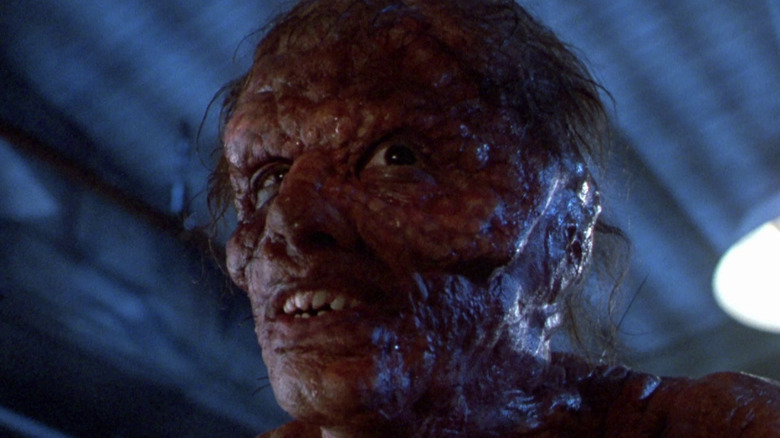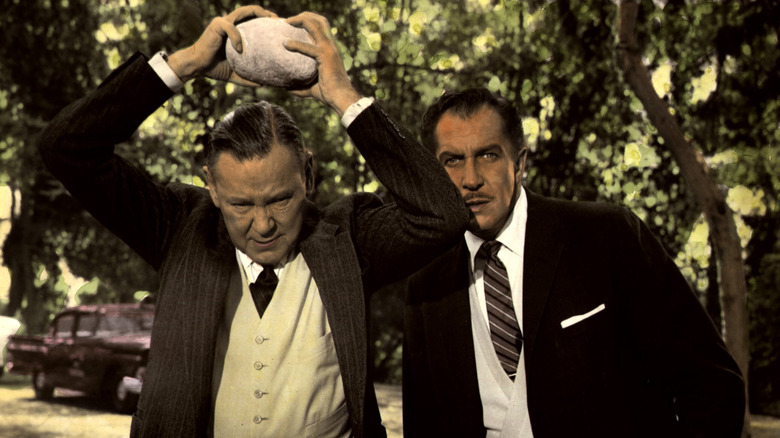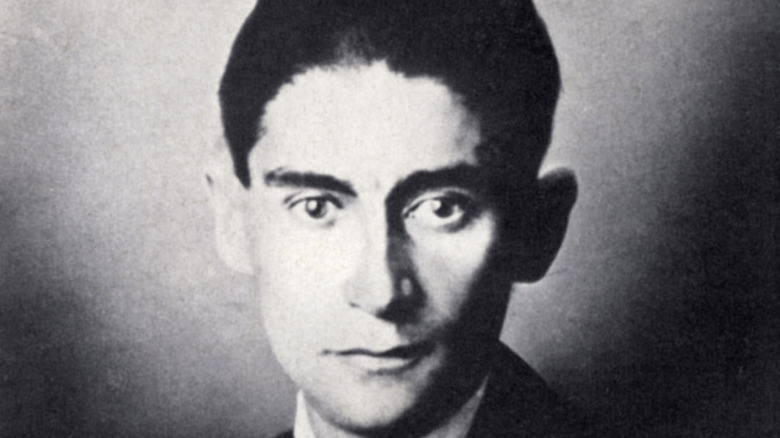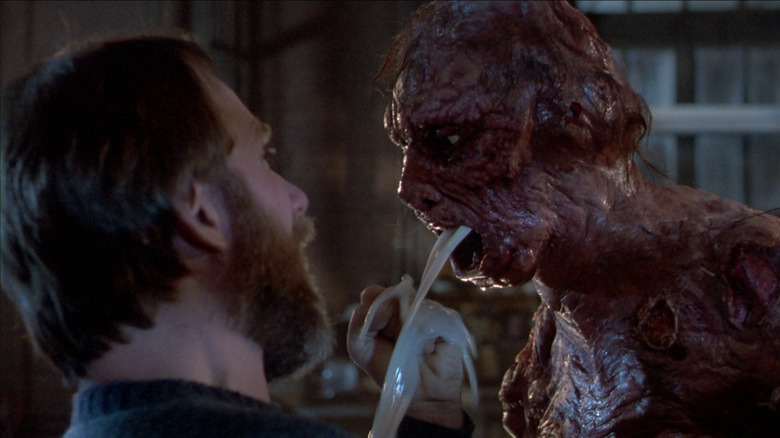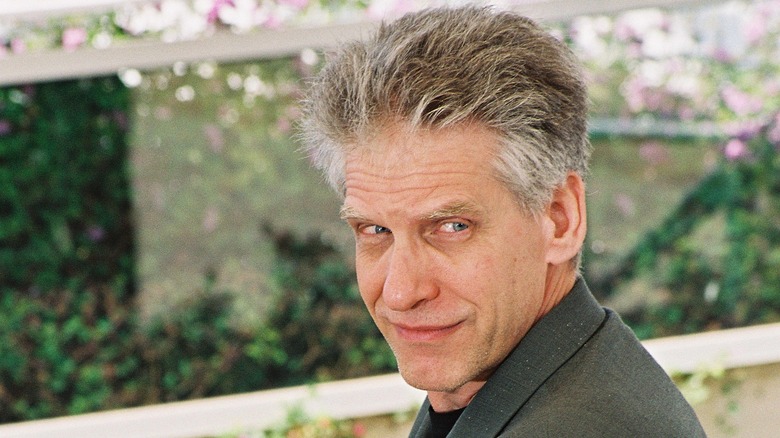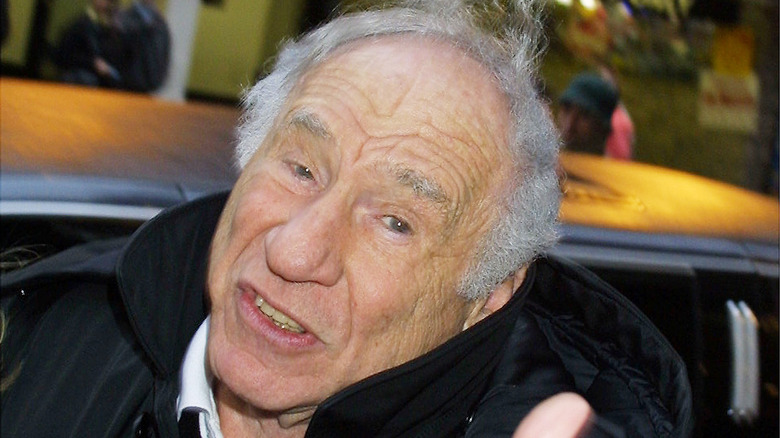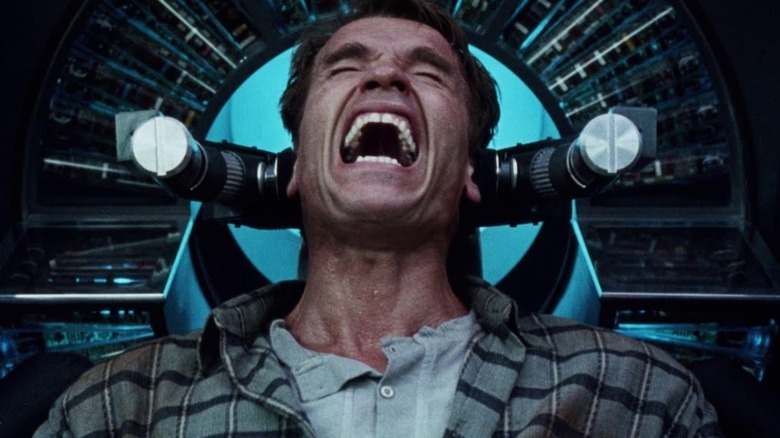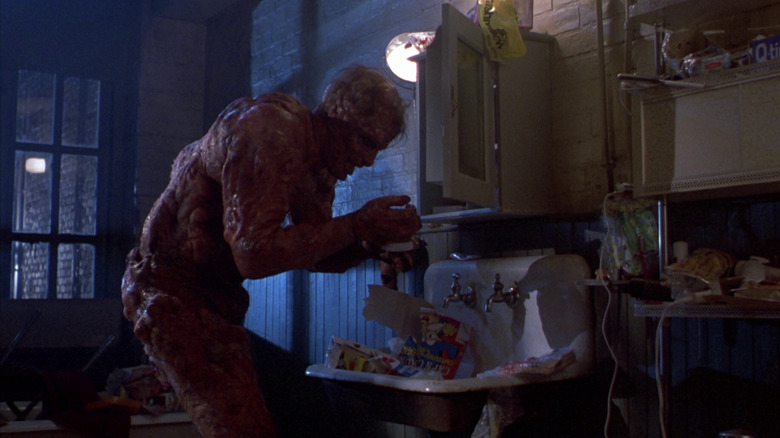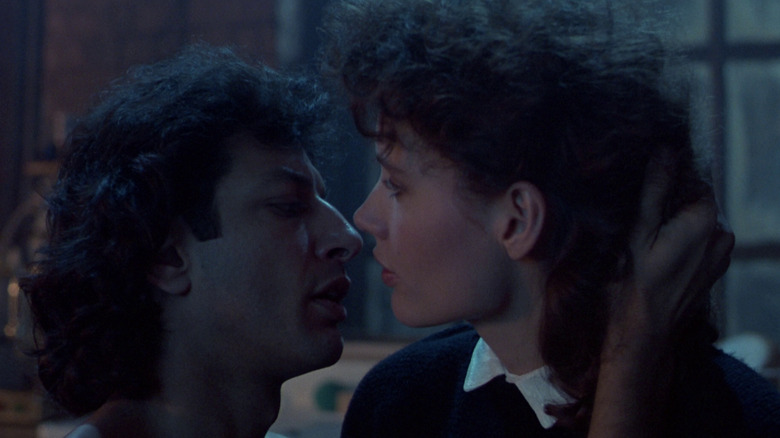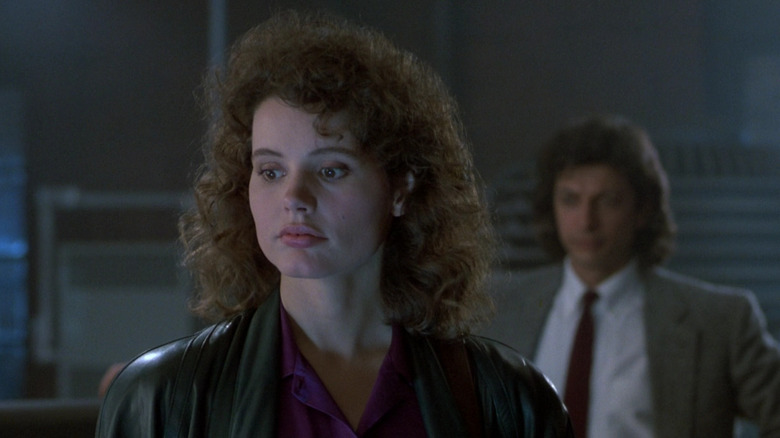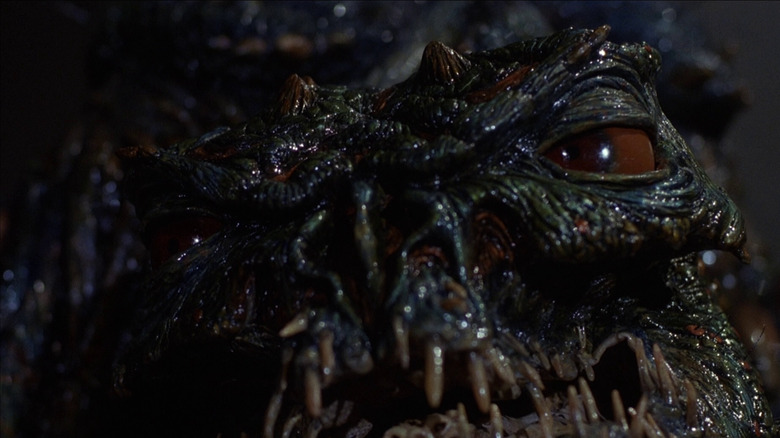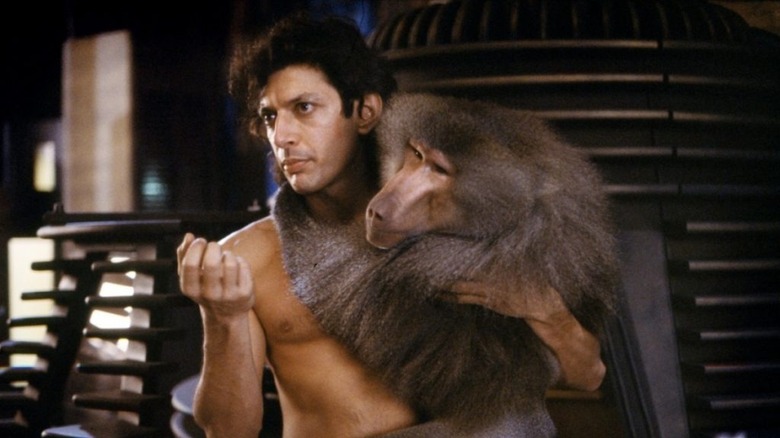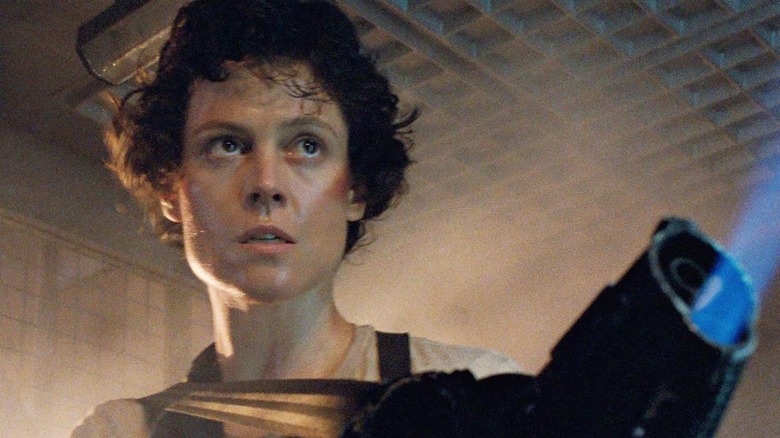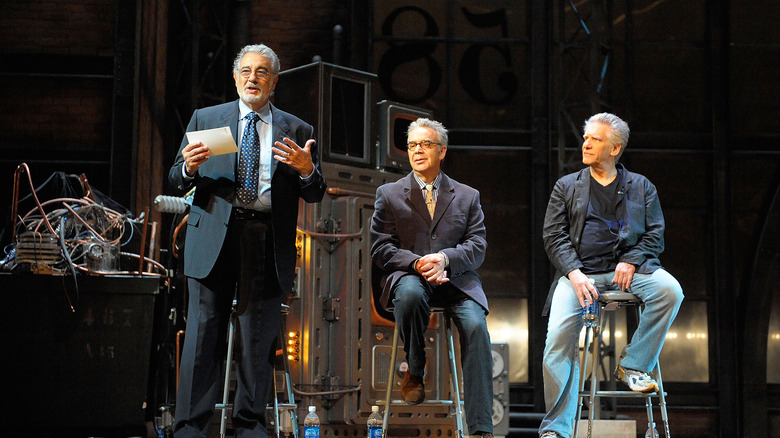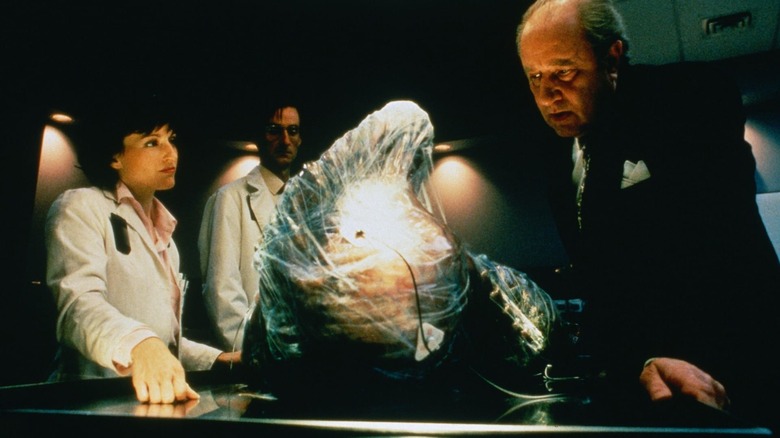The Untold Truth Of The Fly
Within the horror genre, it's common for films to be remade and turned into franchises, often with diminishing returns — they're frequently a pale imitation of the original. But in the late 1970s and 1980s, there were three major exceptions to this trend: Philip Kaufman's "Invasion of the Body Snatchers," John Carpenter's "The Thing," and David Cronenberg's "The Fly." Like the other two masterpieces of sci-fi horror, "The Fly" not only respected its source material, but expanded upon it to create an adaptation that was newer and better than the original.
Cronenberg would be the first to admit that his version of "The Fly" was not the typical horror film of the time, but for that reason, it remains a classic to this day. While the considerable amount of gore shocked audiences and the gruesome practical effects still gross out viewers, there's a genuinely moving story underneath, sure to pull at most people's heartstrings. With "The Fly," we see how the best horror films are far from one-dimensional.
A remake of a 1958 film based on a short story
In 1957, French writer George Langelaan wrote the short story "The Fly," which was quickly turned into a film released just a year later starring Vincent Price. It would be an understatement to say that the sci-fi classic is a bit dated; still, it does feature the famous head-switching scenes that horrified audiences of the time. And even if it seems silly now, the idea of a gigantic spider feasting on your face in the iconic "Help me! Help me!" scene is genuinely terrifying.
The film may not have been popular among most critics, but it was a success at the box office with two sequels, "Return of the Fly" and "Curse of the Fly." In the early 1980s, co-producer Kip Ohman decided to remake the film and brought on screenwriter Charles Edward Pogue, who changed the story in a major way by having the lead character gradually transform into a gruesome monstrosity instead of the simple head swap of the older film.
Kafka's Metamorphosis was a major inspiration
Before director David Cronenberg started production on "The Fly," he reread the classic story, "The Metamorphosis," by Czech writer Franz Kafka. The parallels between the two narratives are obvious. In "The Metamorphosis," a man named Gregor Samsa wakes up one day to find himself transformed into a big bug. After his family discovers him as the giant insect in his bed, they simply force the creature to hide away there, and over time Gregor dies from neglect and depression.
In an essay he wrote for the introduction of a new translation of "The Metamorphosis" that was featured in The Paris Review, Cronenberg explained the similarities and differences between the story and his retelling of "The Fly." To the director, the terrifying transformation of the main character in his film, Seth Brundle, was a metaphor for growing old; The same can be said for the Gregor-bug who perished as if he was aging and bedridden. The most significant difference was that Brundle was not losing his life. Rather, as he underwent this transformation, he was in danger of losing his humanity.
The film was too disgusting for John Lithgow
Jeff Goldblum was not the first choice to play Seth Brundle — far from it. In fact, Cronenberg and producer Stuart Cornfeld barely even got the approval of the 20th Century Fox president Larry Gordon, according to 4:3. But the duo took the risk, and it paid off.
Before Goldblum got the role, John Malkovich was the top choice for Brundle, but the actor declined the offer, while other plans to hire Michael Keaton and Richard Dreyfuss also fell through. Another option was John Lithgow, who publicly gave a more detailed reason why he turned down the role. During an interview with IN Magazine, he says, "I just finished another project and I was exhausted, and I found it such an icky story. I told my agent I just didn't want to play something so grotesque" (via Global News).
Lithgow goes on to add that at the same time he was offered the lead in "The Fly," he also had the opportunity to play a gay character in the film "As If." But his agent was not happy with the situation and told him that he would have preferred to see Lithgow on screen as a fly instead of a homosexual. "This was in 1986," Lithgow says, "Can you imagine?"
Cronenberg does not label The Fly as just a horror film
While David Cronenberg acknowledges that it made sense to categorize "The Fly" as a horror movie, he believes that it is much more than that. In an interview with Lifetime shortly after the release, he explained, "It is a horror film, but of course, as you, yourself, can vouch for, it is also a romance, it's a love story, that's very emotional, very passionate. It's not a gorefest. It's not a slasher movie. It's also very funny, not in a sense of parody or camp. It's an ironic, darkly humorous film, I think."
Years later, when LA Weekly asked if he thought any of his movies were horror films, Cronenberg repeated his belief and says, "I don't. Even when I'm doing something like 'The Fly,' I don't think of it as a horror film in particular. I'm willing to admit that The Fly is a horror film, but the genre part of it sort of takes care of itself."
Cronenberg was certainly not the only one to share this belief. Cinematographer Mark Irwin was once contacted by director Gilbert Cates to work on a romance called "My First Love" because of his work on "The Fly." But when Irwin was confused about why his work on a horror movie would make him a good choice for a romance, Gilbert disagreed with his assessment and said, "No, it's not. It's a love story. What you shot was a love story" (via 4:3).
Mel Brooks created the tagline "Be afraid. Be very afraid."
Unfortunately for the film's first screenwriter Charles Edward Pogue, investors over at 20th Century Fox were not pleased with the script, so they only agreed to distribute "The Fly" if funding could be found elsewhere. Producer Stuart Cornfeld then turned to Mel Brooks, since the two had recently worked together on "The Elephant Man." The legendary director more known for his comedy classics "Blazing Saddles" and "Young Frankenstein" might have seemed like an odd choice, but his production company, Brooksfilms, ended up investing $1 million into the project.
After David Cronenberg was brought on to direct, Brooks made a comment that he thought a better response to, "Don't be afraid," was "Yes, be afraid, be very afraid" (via Entertainment Weekly). Cronenberg thought the line was brilliant and when speaking after a screening of "The Fly" at Los Angeles' Egyptian Theatre, the director says, "He wasn't really giving me dialogue, he was just reacting. And I said, 'Yeah, I'm going to put that in the script.' So let's say it was a collaboration. But yes, it was Mel who came up with [that]."
Co-star Geena Davis says the iconic line in the film, and it was so popular that it later became the main marketing tagline. To this day, it remains one of the most well-known horror taglines of all time.
Cronenberg almost made Total Recall instead of The Fly
Producer Stuart Cornfeld originally wanted David Cronenberg to direct "The Fly," however, he was unavailable due to a prior commitment: Cronenberg was working on his own adaptation of Philip K. Dick's classic science fiction novel "Total Recall." So, Robert Bierman was brought on to direct "The Fly" until a tragedy occurred in which his daughter died on a family trip. Devastated, Bierman could no longer continue the project and the film was left without a leader once again.
Meanwhile, Cronenberg had become frustrated after writing 12 failed drafts for "Total Recall" and decided to give up on it, says Bloody Disgusting. Cornfeld then happened to overhear the news and immediately reached out to the newly-available director. Cronenberg agreed to helm the project, but only under the condition that he was allowed to rewrite the script. The producers approved, and Cronenberg began to make "The Fly" his own.
David Cronenberg heavily revised the script
Charles Edward Pogue's initial screenplay followed the original short story in that the hero was married, but a major change was that the scientist mutated completely into a giant fly. And according to Den of Geek, the main villain would have been the corporate CEO who funded the scientist's project. Cronenberg liked some of these changes, including the gradual, grotesque transformation of Brundle into the fly, and kept them in his version of the script — Seth Brundle still lost pieces of his body and had acid vomit.
Yet aside from those few parts, Cronenberg rewrote everything else, including not just the dialogue, but even the characters. With a new script, producer Stuart Cornfeld needed to make sure that this overhaul was the right decision. He asked director Tim Hunter for his opinion, who confirmed that Cronenberg had nailed it. The third main actor to appear in "The Fly," John Getz, agreed with that assessment and has called Cronenberg's screenplay "perfect" (via 4:3). Even though the script had gone in a new direction, Cronenberg respected Pogue's work and gave him co-author credit.
Geena Davis and Jeff Goldblum were dating
Jeff Goldblum struggled to get the lead role as Seth Brundle, and the same can be said for his co-star, Geena Davis, as well. Cronenberg was especially reluctant to cast her for the role because of the fact that she and Goldblum were a couple at the time. Both Laura Dern and Jennifer Jason Leigh, as well as many others, were rumored to have been in contention for the part of Veronica Quaife instead.
It can be risky to hire actors who are in a relationship because if it goes south, the tension may negatively affect the production and at worst, create a hostile work environment. Fortunately, Davis secured the part alongside Goldblum and the two put in spectacular performances. Their real-life chemistry only made the film more compelling, as audiences were shown the pinnacle of a tragic love story reaching a horrific climax.
Geena Davis' character was her first major role in a film
Potential relationship drama was the main reason Cronenberg was hesitant to cast Geena Davis, but it may not have been the only one. Prior to her appearance in "The Fly," Davis was not a well-known actress, with only minor roles in her previous three films. Along with "Tootsie," "Transylvania 6-5000," and "Fletch," the actress had made a larger splash in television with the lead role in a series of her own called "Sara," which aired for just one season.
After her starring role in "The Fly," things changed dramatically for the actress. First, Davis had another starring role in the hit "Beetlejuice," and then she won an Academy Award for best supporting actress in "The Accidental Tourist." Given her accomplishments, it was only a matter of time before Davis succeeded in Hollywood, but "The Fly" was the role that caused her career to truly take off.
Chris Walas and Stephan Dupuis won an Oscar
Anyone who has seen Seth Brundle's harrowing descent into the hybrid Brundlefly has to give credit to the high quality of the practical effects. Even after 30 years, horror movies with the expert prosthetics and makeup of "The Fly" have a sense of realism that is often lacking in modern films that rely purely on CGI.
The special effects by Chris Walas and Stephan Dupuis were certainly appreciated at the time, since both were awarded the Oscar for best makeup, the sole Academy Award win for "The Fly." On the other hand, the imagery was so real and disturbing to some viewers that they were unable to see beyond the gruesome effects, creating a negative view of the film. When Caryn James of the New York Times reviewed the film, she said, "This all-out, flaunted goriness becomes distracting, and it destroys 'The Fly' ... The plot diminishes to: How can he possibly look worse? And should I watch? This is intense, all right, but not scary or sad, or even intentionally funny" (via 4:3).
There was a deleted "monkey-cat" hybrid creature scene
Regardless of the gruesome visuals, "The Fly" received rave reviews in general from both critics and audiences, but one barbaric scene may have changed that for many if it had been left in the film. Part of the reason that "The Fly" is so successful is that audiences are still made to care about Seth Brundle all the way to the brutal end, a quality that was almost sacrificed thanks to one deleted scene from the original cut.
In a sequence Cronenberg decided to keep from the older screenplay by Charles Edward Pogue, the scientist combined a baboon with a cat after his own hideous transformation had begun. The infamous "monkey-cat" creature that results from the experiment is then bludgeoned to death by Brundle in such a barbaric manner that it would undoubtedly kill any sympathy for the character. Since this was not Cronenberg's intention, he made the wise decision to cut it out of the film.
The Fly took the #1 spot in the box office from Aliens
"The Fly" was a surprise hit that earned over $7 million at the box office during its opening weekend, which was great for the filmmakers, but less so for the studio. Film expert Dr. Dean Brandum explained the bizarre situation to 4:3, saying "For 20th Century Fox, the performance of 'The Fly' was a rare bright spot in a bleak year but it may have been even brighter had it been released with a little more distance from 'Aliens'."
Because the studio did not expect "The Fly" to do so well, James Cameron's "Aliens" had only been out for a month before their latest film stole the limelight and knocked their reigning hit off the top spot. "Aliens" still did well and managed to gross $4.3 million that same weekend, narrowly lost second place to "Armed and Dangerous" with John Candy, and remained in the top five for nine more weeks. The problem was that it had already been a rough year for Fox, so the company lost even more money with their two major films competing with each other over ticket revenue.
The Fly opera was based on the film
After decades of writing music for films, Howard Shore, the composer of "The Fly," returned his focus to the stage. In 2008, he teamed up with Cronenberg to create an opera based on the sci-fi horror movie. In an interview with the New York Times, Shore said, "I always thought it to be a classical opera theme. A great story of love and death, of true love that survives physical decay and the ultimate sacrifice."
For the most part, the operatic version stuck with the same locations, characters, and plot points as the film, albeit with some minor changes. For instance, the opera takes place in the 1950s, and features a slightly different ending involving Veronica Quaife's unborn child. The film ends with the fate of the baby left unknown, while the opera version has the mother state that she will have the child out of love for the man she lost.
Unfortunately for Shore, his opera adaptation was not received well by the critics, according to Wired. While the sets created by the famous designer, Dante Ferretti, were praised, there was not much love for the rest of the production as the opera was given negative reviews almost across the board.
David Cronenberg wrote a script for another Fly movie
After his excellent special effects in "The Fly," Chris Walas was given the opportunity to helm the sequel, but according to Bloody Disgusting, the film is considered by many to be one of the worst sequels of all time. The main reason he sat in the director's chair for "The Fly II" was that Cronenberg ultimately refused to take on the project, since he had no desire to film sequels to any of his movies. He was, however, interested in continuing the story in a way that would not have been a true sequel, nor a remake, and he even wrote the script for this unique dive back into one of his classic films.
When 20th Century Fox approached him again years later to possibly direct a remake, there was a glimmer of hope for the revival of his idea, but disagreements between the director and the studio killed any progress that was made. When talking with CinemaBlend, he was mostly pessimistic about the project and says, "Of course technology has changed hugely in the last 25 years, so I was interested to see for myself what I would come up with. There was no guarantee that I would like what I came up with, or that they would. It turned out we both liked it, but it looks like it's not going to happen. But you never know. Maybe it will eventually."
